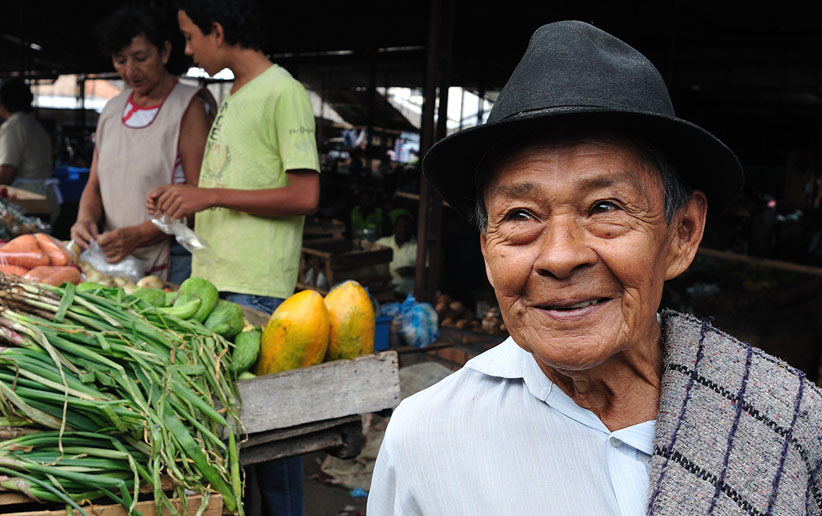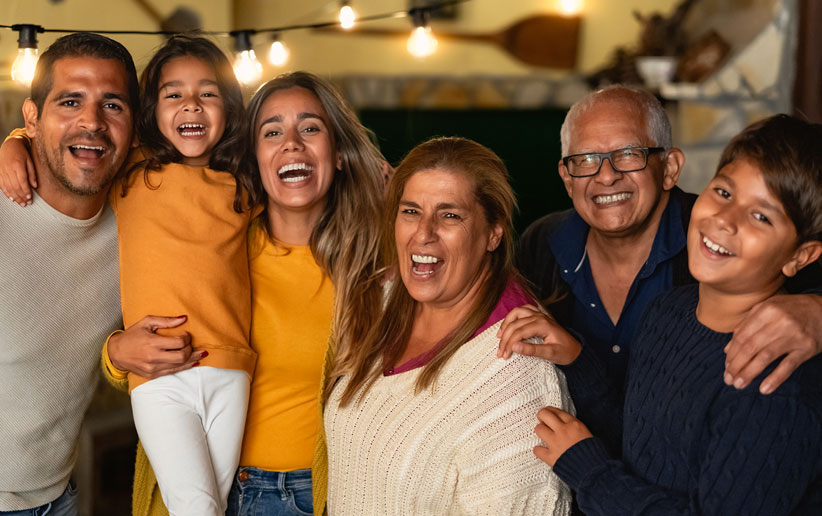A topic seldom discussed is the challenges that daughters of Latin American immigrants face and overcome when seeking higher education. Studies have shown there has been an increase in Latin women pursuing higher education than in previous years (Mora, 2022). Despite the growing numbers, attainment of degrees often stays the same due to the incompletion of a program. In other instances, it has been shown that students take a longer time to complete a program than the traditional four years. Studies have now started to shed light on the challenges that Latin daughters face when obtaining higher education, but there continues to be a lack of discussion on how we can begin to support them. To better understand how we can support daughters of Latin immigrants, we must first try to understand their worldview. In order to do this, I will be going over some of the cultural concepts that play a role in a Latin daughter’s life.
Latin culture places a lot of importance on values such as familismo and gender norms, such as machismo and marianismo. Familismo is one of the traditional values embraced in Latin culture due to its focus on loyalty and support to one’s family (Ackert and Wikle, 2021). Those with higher levels of familismo always take family into consideration, including when making personal life decisions (Valdivieso-Mora et al., 2016). This is often seen in individuals who identify more with Latin culture. However, this can be different for those individuals who are Latina but perhaps also identify or interact within other cultures, such as that of the United States. The culture in the US is more individualistic, and therefore, studies have found that familismo levels within this culture can be lower than that of a collectivistic culture (Smokoski et al., 2009; Valdivieso-Mora et al., 2016).
Individuals who embrace machismo may also embrace familismo, but their support of their family looks different than that of their female counterpart.
Gender norms are also traditionally embraced within Latin culture. It is often seen in concepts and values such as machismo and marianismo. Machismo highlights the expectations of men and can be seen through characteristics such as dominance and aggression, amongst others (Nuñez et al., 2016). Within the concept of machismo, men are expected to be dominant and oftentimes perpetuate dominance through strength, bravery, and financial support for their families. Individuals who embrace machismo may also embrace familismo, but their support of their family looks different than that of their female counterpart.
On the other hand, Latin women and daughters are expected to embrace marianismo. Marianismo describes the ideal woman and their role within their family. They are expected to be passive and self-sacrificing (Nuñez et al., 2016)—characteristics deriving from the Virgin Mary (Niemann, 2004). Latin daughters are often taught to take on multiple roles in the family—this is especially observed within those who identify as the oldest daughter (Longoria et al., 2020; Sy & Romero, 2008; Valenzuela, 1999). Traditionally, tasks that are given to daughters include caretaking, cleaning, and cooking. These were often given so that daughters would learn to be good homemakers and mothers. Marianismo is still a construct found within Latin families, however, it does not look exactly the same in the United States. Daughters of immigrant Latin families are still expected to learn to care for their families and are still taught to care and respect their families, but additional expectations are placed upon them.

Latin immigrant parents understand the importance of their children obtaining a higher education in order for them to have more job opportunities. In turn, this allows children to have the means to support the family when their parents can no longer do so. Because of this, there is an additional expectation for their children to go to college and get a degree. This can be an easy task for some, but for some Latin daughters, this is not always easy.
For Latin daughters, obtaining higher education often means an additional task on top of their current responsibilities. The first challenge with obtaining higher education often starts with applying. Many daughters of Latin immigrant families do not always have the opportunity to go to the best schools and are forced to apply to local schools—normally two-year colleges. This is often because they must stay home to help support their families and/or family members (Gonzales et al., 2013; Jabbar et al., 2019). If Latin daughters have the opportunity to go to school away from home, they have to learn to navigate between their familial roles and their student roles. This may look like helping family with tasks despite being away at school while also completing their own school tasks and/or working to help financially support themselves and family back home. Other times, daughters of Latin immigrants whose families hold strong familial and cultural values are in a double bind in which they must uphold family values and requests, but at the same time uphold the expectation to obtain a higher education. Interviews have emphasized the experience of guilt amongst Latin daughters as they struggle to meet family or parental expectations because they must meet the demands of their school (Camargo Gonzales, 2020).
So, how can we as clinicians and systemic thinkers begin to support Latin daughters navigating higher education?
First, we must make an effort to learn and understand our client’s experiences. We can do this by not shying away from questions related to race, ethnicity, religion, family of origin, immigration, social justice, etc. This will provide the client a safe space to talk about topics related to their identity, upbringing, and day-to-day experiences. This conversation should also discuss the client’s ability to codeswitch and/or navigate two different worlds—one which emphasizes collectivism and familismo, and the other which emphasizes independence and individualism. All these topics will help therapists to understand the client’s worldview.
As clinicians, we must also remember to address not only the challenges, but also make room for conversations related to strength, resilience, and empowerment. It can be important for clinicians to remember that sources of these can be anything, including those same things that make situations challenging, such as our cultural and ethnic identity. It is also relevant in these conversations to discuss the importance of obtaining help. In many cases, Latin daughters have been taught to be hyper-independent so as not to burden anyone. Because of this, the therapist should also address the client’s support system—and in some cases, help create them. This will be useful to help them navigate their unique challenges.
As systemic clinicians, we must also do our best to get more than one person in the therapy room. We should encourage the client to bring parents or family members into therapy to help discuss the needed support. This should be done carefully by taking into consideration the client’s and family’s cultural expectations and needs, as they may only be able to provide a limited amount of support because of this. However, highlighting a space of belonging can help foster increased self-esteem and motivation as they strive to be the best for themselves and their families.
Other ways you can help support Latin daughters who are currently navigating higher education is through mentorship—especially those readers who identify as Latin American and went through a similar journey. You can help empower and support those individuals going through this experience by providing support and resources that were helpful to you throughout your journey. Oftentimes, it is also helpful to hear from others with similar experiences who were able to obtain their degree(s) and now hold faculty or supervisory roles. Interviews with Latina students highlight the need for more Latina mentors as it helps students combat feelings of imposter syndrome, especially when they are attending academic institutes that are predominantly White (Camargo Gonzales, 2020; Medina & Luna, 2008). We can help support Latinas to overcome the systemic and psychological barriers that they will encounter as they navigate higher education.
>>AAMFT Workshop: Building Pathways of Success for Latinas in MFT
As systemic clinicians, we must also do our best to get more than one person in the therapy room. We should encourage the client to bring parents or family members into therapy to help discuss the needed support.

Jacqueline Florian, MA, LMFT, is an AAMFT Professional member and associate marriage and family therapist who provides mental health services to children and families in marginalized communities. Her research focuses on the impact of separation and detention on the parent-child relationship. As a first-generation Latina, Florian is aware of the struggles that Latinx families face and has made it her goal to advocate for the BIPOC community. She is also a doctoral student at Alliant International University, Los Angeles.
Ackert, E., & Wikle, J. S. (2021). Familism among Latino/a adolescents: Evidence from time-use data. Journal of Marriage and Family, 84, 879-899. https://doi.org/10.1111/jomf.12809
Camargo Gonzalez, L. (2020). “The weight we carry in our backpack is not the weight of our books, it’s the weight of our community!”: Latinas negotiating identity and multiple roles. InterActions: UCLA Journal of Education and Information Studies, 16(1). https://doi.org/10.5070/D4161043602
Jabbar, H., Serrata, C., Epstein, E., & Sánchez, J. (2019). “Échale ganas”: Family support of Latino/a community college students’ transfer to four-year universities. Journal of Latinos and Education, 18(3), 258-276. https://doi.org/10.1080/15348431.2017.1390462
Longoria, D. A., Rodriguez, N. M., Gonzalez, J. M., & Escobar, R. (2020). Latina daughter and their caregiving roles. Journal of Mental Health and Social Behaviour, 2(1), 1-4. https://doi.org/10.33790/jmhsb1100120
Medina, C., & Luna, G. (2008). Narratives from Latina professors in higher education. Anthropology & Education Quarterly, 31(1), 47-66. https://doi.org/10.1525/aeq.2000.31.1.47
Mora, L. (2022). Hispanic enrollment reaches new high at four-year colleges in the U.S., but affordability remains an obstacle. Pew Research Center. https://www.pewresearch.org/short-reads/2022/10/07/hispanic-enrollment-reaches-new-high-at-four-year-colleges-in-the-u-s-but-affordability-remains-an-obstacle/#:~:text=In%202021%2C%20about%20three%2Din,of%20Current%20Population%20Survey%20data
Niemann, Y. F. (2004). Stereotypes of Chicanas and Chicanos: Impact on family functioning, individual expectations, goals, and behavior. In R. J. Velásquez, L. M. Arellano, & B. W. McNeill (Eds.), The handbook of Chicana/o psychology and mental health (pp. 61–82). Lawrence Erlbaum Associates Publishers.
Nuñez, A., González, P., Talavera, G. A., Sanchez-Johnsen, L., Roesch, S. C., Davis, S. M., Arguelles, W., Womack, V. Y., Ostrovsky, N. W., Ojeda, L., Penedo, F. J., & Gallo, L. C. (2016). Machismo, marianismo, and negative cognitive-emotional factors: Findings from the Hispanic community health study/study of Latinos sociocultural ancillary study. Journal of Latinx Psychology, 4(4), 202-217. https://doi.org/10.1037/lat0000050
Smokowski, P., Buchanan, R. L., Bacallao, M. L. (2009). Acculturation and adjustment in Latino adolescents: How cultural risk factors and assets influence multiple domains of adolescent mental health. The Journal of Primary Prevention, 30, 371-393. https://doi.org/10.1007/s10935-009-0179-7
Sy, S. R., & Romero, J. (2008). Family responsibilities among Latina college students from immigrant families. Journal of Hispanic Higher Education, 7(3), 212-227. https://doi.org/10.1177/1538192708316208
Valdivieso-Mora, W., Peet, C. L., Garnier-Villarreal, M., Salazar-Villanea, M., & Johnson, D. K. (2016). A systemic review of the relationship between familism and mental health outcomes in Latino population. Frontiers in Psychology, 25(7), 1632. https://doi.org/10.3389/fpsyg.2016.01632
Valenzuela Jr., A. (1999). Gender roles and settlement activities among children and their immigrant families. American Behavioral Scientist, 42(4), 1-18.
Other articles
From Adversity to Empowerment: Using Ancestral Stories to Guide Latinx Therapy
The Latinx community finds richness in the art of storytelling folk traditions that have shaped many Latin-American countries since the times of their independence from Spain in the 19th century (Miller, 2004). As bilingual marriage and family therapists (MFTs), supervisors, and instructors at a Hispanic-serving institution, we have witnessed the relevance and power of using culturally attuned stories with our clients.
Julian Crespo, PhD & Carlos Ramos, PhD
Beyond Our Struggles: Addressing Stereotypes in Latinx Families
In 2020, the U.S. Latinx population reached 62.1 million, constituting 19% of the entire American population. This positions it as the second-largest racial or ethnic group in the nation, following White Americans, as reported by the U.S. Census Bureau (2021).
Sandra Espinoza, PsyD & Mandee Duran, BA
Mothers’ Lived Experiences with an Incarcerated Son: A Research Brief
With an estimated 2.2 million people incarcerated, the United States (U.S.) continues to have the highest incarceration rate in the world (Beckett et al., 2018). Stress, trauma, and stigma are common negative effects of incarceration on the well-being of the individual and their loved ones (Turney & Goodsell, 2018). For an already vulnerable group, the effects of incarceration can have devastating effects on the entire family system (Beckett et al., 2018; Lee et al., 2015; Wakefield et al., 2016).
Eman Tadros, Sarah Presley, & Yenitza Guzman



